Creating New Instances
This guide explains how to create a virtual machine (VM) using Radiant’s Horizon OpenStack Dashboard. There is also a description of how to access your new VM and how to mount persistent storage volumes.
Creating a VM
In the Details tab:
Name your instance.
For Availability Zone make sure “nova” is selected (unless you are creating an instance with a GPU).
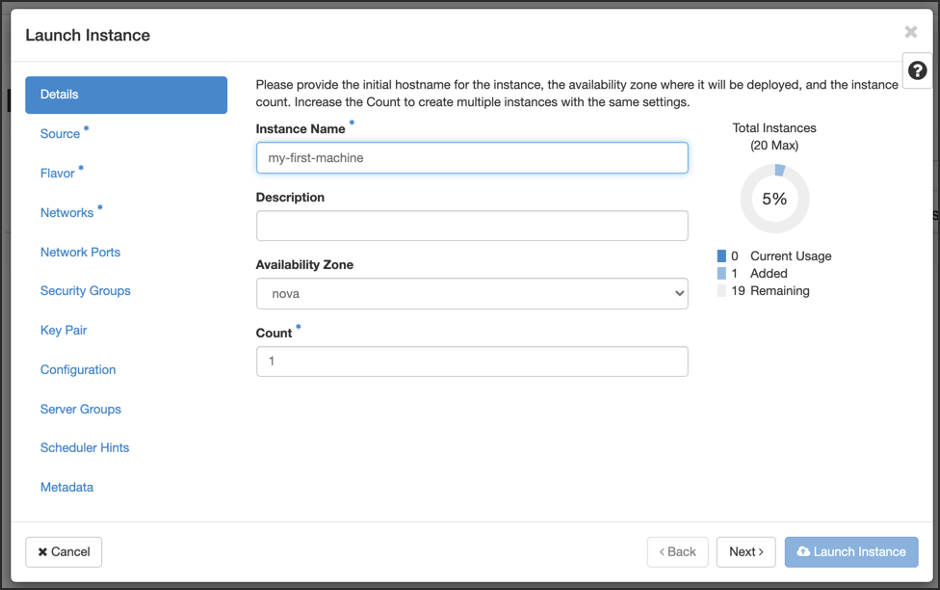
In the Source tab:
Select the base OS and where to run.
The create new volume option defaults to “Yes”. This will count against your flash storage quota as well as take up one of your volumes. This is good if you want your data to persist after you tell OpenStack to delete your instance.
If you create a new volume you can pick the size of the volume.
If you select “No”, it will use the default size for the Flavor (see step 3).
You also need to select the base image you want to start with. (The list of available images might change over time.)

In the Flavor tab, select the flavor. (The list of available flavors may change over time).
If you select a flavor that will use too many resources, you will see a yellow exclamation mark (!) next to it.
If you selected “No” for the create new volume option in the Source tab, the volume will be the same size as the root disk.
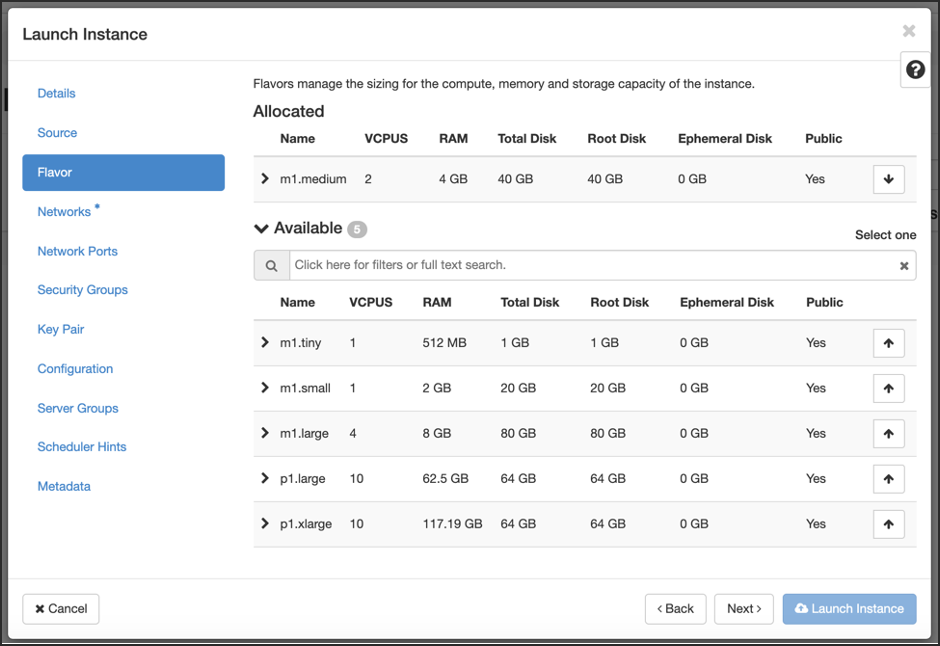
In the Networks tab, select the network.
You may see a few network options to choose from. Look for a network that is <project_name>-net, for example bbdf-net, where bbdf is the name of your project.
Warning
Don’t pick ext-net; if you do, your instance will fail to be created.
By default, the <projectname>-net network does not allow for external connections. Only other hosts on that same network will be able to reach this machine. This is fine for a host that only needs to be reachable from other hosts within your network.
If you need to set up a host that is reachable from outside your network, you will need to associate a floating IP address to your instance. This is set up after an instance is created (see Assigning a Floating IP to your Instance).
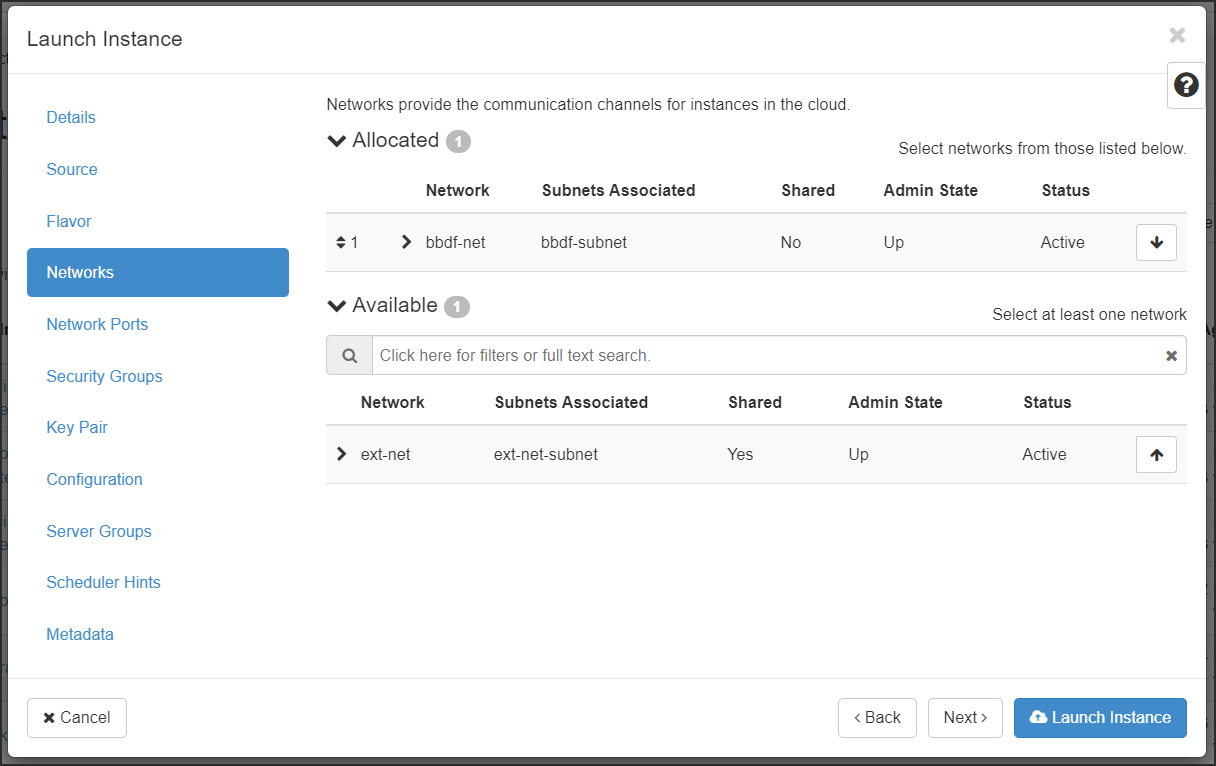
The Network Ports tab can be left unmodified.
The Security Groups tab allows you to allocate additional security groups. It is good to add remote SSH to allow you to SSH to the host.
If a port is not opened in the security group, you will not be able to reach that host on that port. This is basically a firewall that blocks all incoming traffic by default.

In the Key Pair tab, select an existing key pair or create a new one.
If you do not select a key pair, you will not be able to SSH into this machine. The default behavior for most base images is to not have a user with a password.
See Did you use the correct username? for a list of common usernames for each image.
If you create a new key, make sure to copy the private key and save it to disk. It’s best to save it as .pem file on your workstation/laptop; your OS may add extra formatting if you give it a different extension. Save it in a path where you will have easy access for your later SSH sessions.
Warning
Don’t lose this .pem file or you will have to start your VM instance again, from scratch.
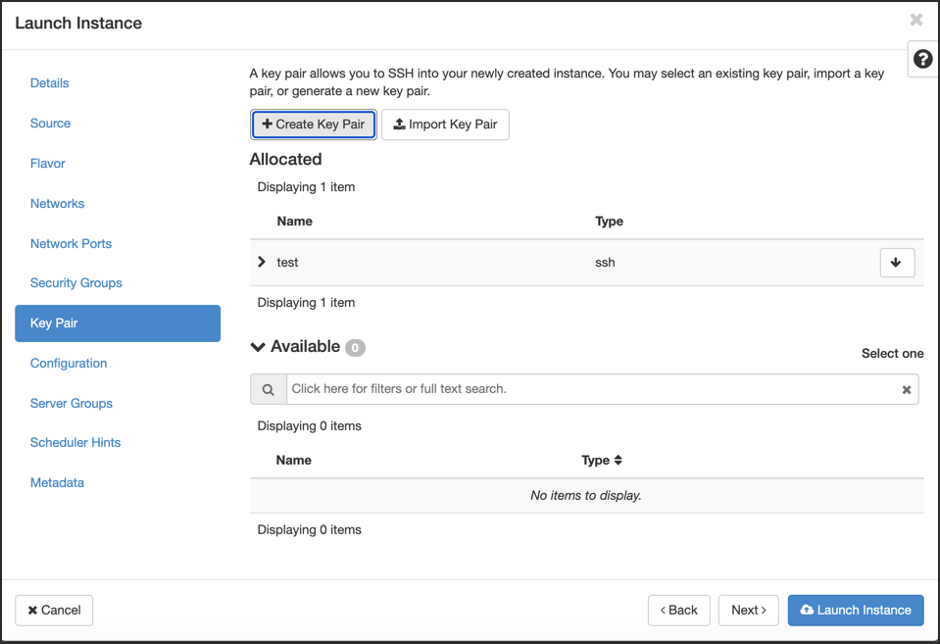
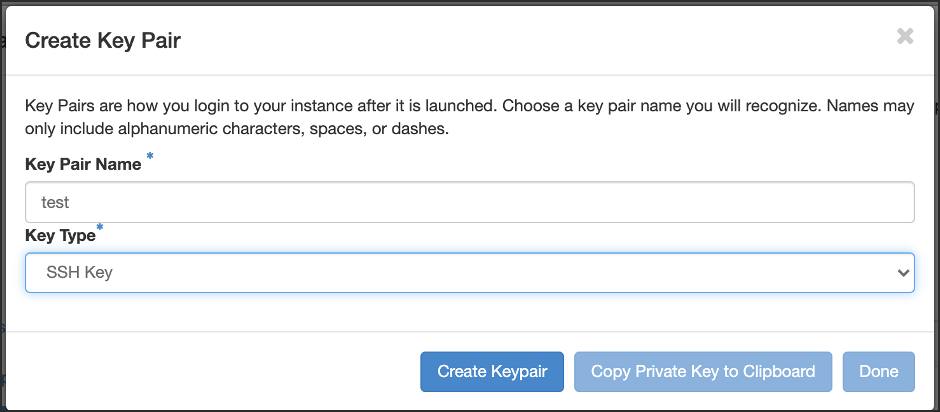
The Configuration tab allows you to configure the new machine on boot. You can use this to install programs or do anything else on first boot.
Warning
You need to check the Configuration Drive box. The default is for it to be unchecked. If you leave it unchecked, your key and/or startup script will not work.
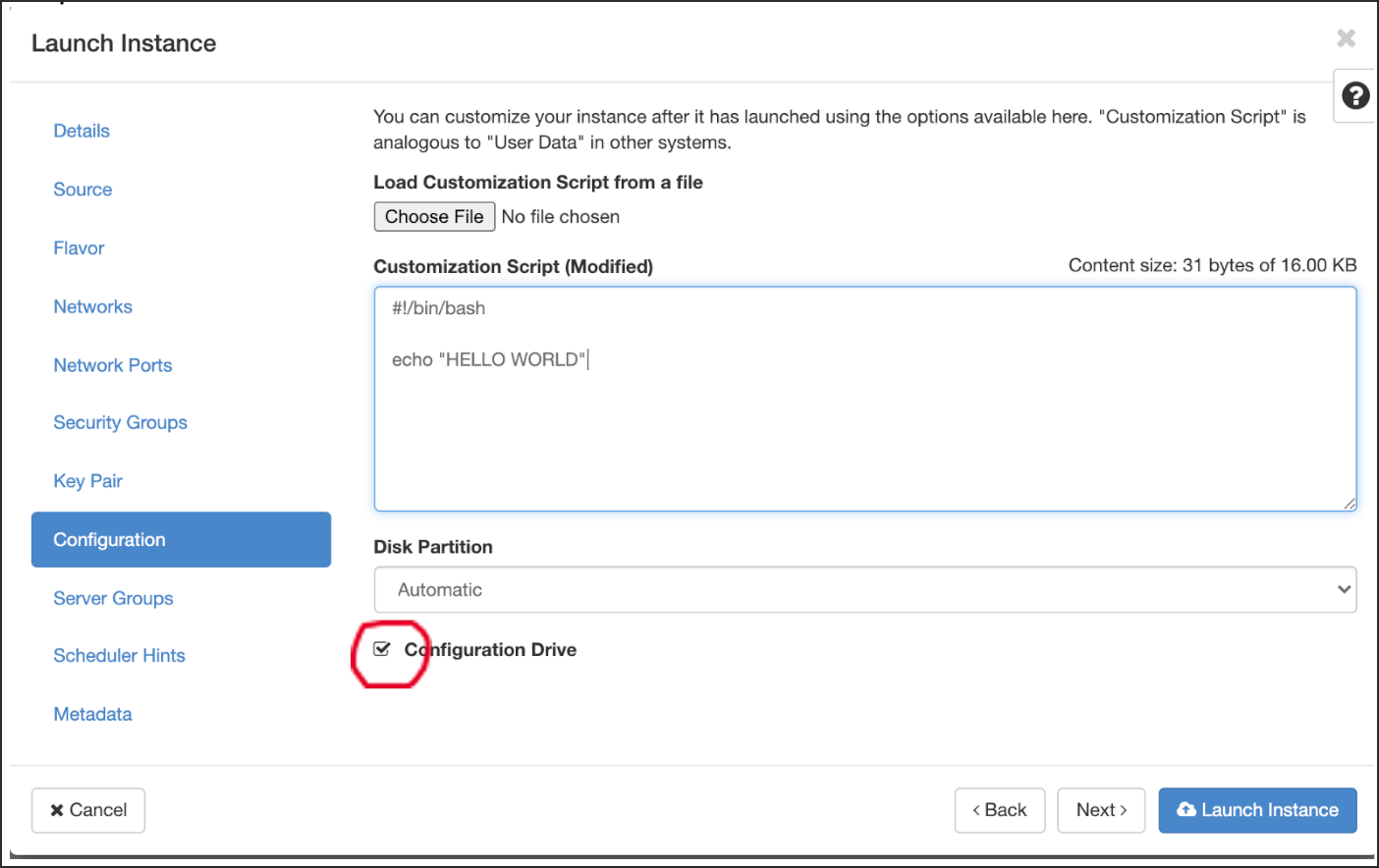
The Server Groups, Scheduler Hints, and Metadata tabs can be left unmodified.
Click the Launch Instance button to launch your instance. It should be ready in a few minutes; you can see it listed in the dashboard under Instances.
Assigning a Floating IP to your Instance (Optional)
If your instance needs to be reachable from the internet, you need to assign a floating IP address to it. Otherwise, you can skip this section.
Locate your instance in the list and click the down arrow button in the actions column.
From the drop-down list select Associate Floating IP.
From the IP Address selection box, pick an available IP. This will be the floating IP for your instance.
For Port to be associated you can usually leave the default, but if you have multiple interfaces you can select the appropriate port.
Click the Associate button.
Accessing your Instance
Once the instance is active and running, you should be able to SSH to it. To do this, you’ll need the IP address, username, and key.
ssh -i test.pem centos@IP_ADDRESS
IP_ADDRESSis the IP address assigned to your instance.If you assigned a floating IP, use that when you SSH from an external host.
If you SSH from a host on your project’s own network, you can use the IP assigned on the project interface.
test.pemis the key you savedcentosis the username. Depending on the OS you picked this may be different, see Did you use the correct username? for a list of common usernames for each image.
If you get an error that the permissions on the key are too open, you can change them using chmod 600.
Running in the System
If you want to use more disk space, first make sure you mount in Taiga bulk storage. Each instance only has 40GB of storage that is primarily used for the OS.
You can mount additional Taiga Bulk storage via NFS using:
mount -t nfs taiga-nfs.ncsa.illinois.edu:/taiga/ncsa/radiant/bbXX /mnt/point
bbXXis your unique Radiant project code/mnt/pointis the target mount path
This will make your bulk storage space available on your machine. There will be a few minutes between when your machine boots and when the space can be mounted.
Change your Root Password
Once you’re able to log in remotely as root, be sure to change the root password on your instance. This allows you to access your instance’s console via the web interface if you can’t SSH in later.
# Ensure that you create a secure password and that you save it in an appropriate password manager
sudo passwd
Troubleshooting
Trouble Accessing Systems
Did you add “remote SSH” as a security group?
If not, add the group to the instance in the Security Groups tab.
Does the SSH attempt state that the key is an “invalid format”?
The .pem file must contain no extra characters or line breaks in a text editor, it should look like this:
-----BEGIN RSA PRIVATE KEY----- MIIEowIBAAKCAQEAmN7qws0+gxKKczyFkkngz+uoAzmcHm5HTLvuOz8OatQhAlG1 EzqjI9IDKTZtM7lhvj+6lwCeieLqn8J6Y5/T25k8nLb8pufJvXgtfl8b4gv/Y/KX ULfHhVNE+qzl95FmkaJwxe5TFtWvlpDRxdOgCfKrLvgaWI+vrUXfhfmsl6YRHHLb UrnH/vyo3/m6T1rspNdFgCwXy4elLBEVuAqj4uxqkBNDKGeeAuBJ5dBxMJaD+aWZ dz3GejoXWJ1MvGAjmZ/oQghgvmz18grpw6OeVx1CTlQ2KoRyaOUW8cCum5BYQv9v zX2KDw1PCHdZKZeAZq9Qia98mlvEPdpaN+0dIQIDAQABAoIBAQCKOg62hBWBOTOd TV1N0KWJ/ADYoa/ryDWKSef5BGRJ7nPGgBEmSQAYtJ4NFtyZR4f9Gezi+zlfXqJe QOCf0nYje6TV45QCa1X8j307Zk51D/om6sUtxG+Ru6CEte/e8kd3ahVks8HHxQJX N62mnlt4g0eMWeSgrZPhLmwV3ZPVLntCUIqiEVYmfSMAmuSruNXKTt3JEYCy7wbo e0+HBHem16l1v+ADf8vKs3wfQ6L7jSXK9ihN4EFFbb+MxQXZCFCWMZMfWkpV7qZw UiYjjnLz97fF1d38IJCgZJ/qJTHuIoAxbA2pckXQCT+ttrFdjMo6lsKC5iZ7xcBO ryHN97ZtAoGBAMiPWLUWMfn9+kXKTYXBmm8gRqRQsHB0KIgQmo1oZW1lQMRsc4Ys WiWWRYfkup8x+cp+S8TUxfe7LWsjWa718q9QE8g9wLvLypm16WkxnQsCTz/yW7QG HP33G8zq+FLrncdXN7/77gYNAQJ56ZksOjMl9NQgHP4roOazmQ1ltWrHAoGBAMMg 1smbuORi/8M+vT4EJx5oXYgz/eun+/lpv9xE7oZmubw5wzuGY5sjREWVnxnNFkIV rfHNorI0jc6JeeG4WivcJ7fDE3bTiNKz8JJbcavAIxNpjNQO9QkxCWjtt6k0TE8K gvasYxrQb8pSR3nSqis31WY2mg+W/u5nTeHW/BDXAoGAAl5fB9R5RqCPQh+/hqLg tgtFik9BpjJZADJiAOWIvSADAc7eFmmTrvn1XEOBSLwIXTHcpzh0Fhbp1GgYeQ6C jTt+4FCKZC1l+SbC2PEzD5w5X2H3X0rrMLyoYWUtBZ2uwVnwWJ4bE4s3xdW2wo5Z KZ17JL40WXQedFsOpa/b0qUCgYAVtH9v6ayFayW8GCyAy4F2dnGBBxeFsSfsNIEt BVXrCV47u8klw+sshJ3Bh8Us341MSJESxqcEX6gug0hVfWY6XsDkRgTSQPGFTpLC FP3t9u9v51vM8uT64sODMn4tii261RaATeiwQONOhByDRpW7PPi15/j3Jvqwljkp l/pt/QKBgFTlbV9jkl7Pke4NC+yCrhe79qTvJrLJ8hFJwnw+zGdrlG2tyWK6J7Ar lSPGPMYLo7ExA2J4JxsNes1PVHpXiXIelHUsiQQDaz/RBzMJgpds3M1MU5Nl0HtW r9M2paxYkiUqsM5ojDktjB0IpxNG4mWzL07D4MW4YzxCbRWU/kA6 -----END RSA PRIVATE KEY-----
Did you use the correct username?
Common Usernames OS
Username
CentOS
centos
Ubuntu
ubuntu
CoreOS
core
RedHat
cloud-user
Rocky
rocky/cloud-user
Trouble in the System
Are you out of disk space?
Make sure to mount Taiga storage for all your data. You only have a small amount of root storage.